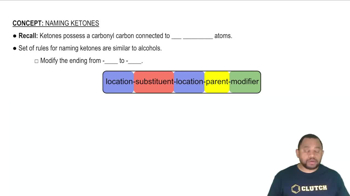Here are the essential concepts you must grasp in order to answer the question correctly.
Aldehydes
Aldehydes are organic compounds characterized by the presence of a carbonyl group (C=O) at the end of a carbon chain. The general formula for aldehydes is RCHO, where R represents a hydrocarbon chain. In the case of hexanal, it consists of a six-carbon chain with the carbonyl group located at the terminal carbon, making it a straight-chain aldehyde.
Recommended video:
Rules for Naming Aldehydes
Ketones
Ketones are organic compounds that contain a carbonyl group (C=O) situated between two carbon atoms, which distinguishes them from aldehydes. The general formula for ketones is RC(=O)R', where R and R' can be the same or different hydrocarbon chains. Understanding the structure of ketones is essential for recognizing their properties and reactivity in organic chemistry.
Recommended video:
Structural Representation
Structural representation in organic chemistry involves depicting the arrangement of atoms within a molecule, including bonds and functional groups. For aldehydes and ketones, this includes showing the carbonyl group and the carbon chain. Drawing these structures accurately is crucial for visualizing molecular interactions and predicting chemical behavior.
Recommended video:
 Verified step by step guidance
Verified step by step guidance


